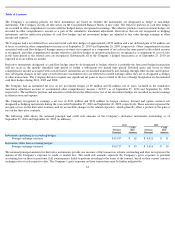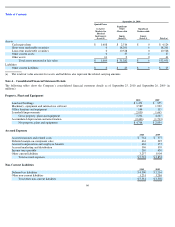Apple 2010 Annual Report Download - page 60
Download and view the complete annual report
Please find page 60 of the 2010 Apple annual report below. You can navigate through the pages in the report by either clicking on the pages listed below, or by using the keyword search tool below to find specific information within the annual report.
Table of Contents
Fair Value Measurements
During 2009, the Company adopted the FASB’
s new accounting standard on fair value measurements and disclosures for all financial assets and
liabilities. The new accounting principles define fair value, provide a framework for measuring fair value, and expand the disclosures required
for fair value measurements. During the first quarter of 2010, the Company adopted the new fair value accounting principles for all non-
financial
assets and non-
financial liabilities, except for items that are recognized or disclosed at fair value in the financial statements on a recurring basis,
which did not have a material effect on the Company’s financial condition or operating results.
The Company applies fair value accounting for all financial assets and liabilities and non-
financial assets and liabilities that are recognized or
disclosed at fair value in the financial statements on a recurring basis. The Company defines fair value as the price that would be received from
selling an asset or paid to transfer a liability in an orderly transaction between market participants at the measurement date. When determining
the fair value measurements for assets and liabilities, which are required to be recorded at fair value, the Company considers the principal or
most advantageous market in which the Company would transact and the market-
based risk measurements or assumptions that market
participants would use in pricing the asset or liability, such as inherent risk, transfer restrictions and credit risk. In accordance with the fair value
accounting requirements, companies may choose to measure eligible financial instruments and certain other items at fair value. The Company
has not elected the fair value option for any eligible financial instruments.
Foreign Currency Translation and Remeasurement
The Company translates the assets and liabilities of its non-
U.S. dollar functional currency subsidiaries into U.S. dollars using exchange rates in
effect at the end of each period. Revenue and expenses for these subsidiaries are translated using rates that approximate those in effect during the
period. Gains and losses from these translations are credited or charged to foreign currency translation included in accumulated other
comprehensive income in shareholders’ equity. The Company’
s subsidiaries that use the U.S. dollar as their functional currency remeasure
monetary assets and liabilities at exchange rates in effect at the end of each period, and inventories, property, and nonmonetary assets and
liabilities at historical rates. Gains and losses from these remeasurements were insignificant and have been included in the Company’
s results of
operations.
Segment Information
The Company reports segment information based on the “management”
approach. The management approach designates the internal reporting
used by management for making decisions and assessing performance as the source of the Company’
s reportable segments. Information about
the Company’s products, major customers and geographic areas on a company-wide basis is also disclosed.
Business Combinations
In December 2007, the FASB issued a new accounting standard for business combinations, which established principles and requirements for
how an acquirer is to recognize and measure in its financial statements the identifiable assets acquired, the liabilities assumed, and any
noncontrolling interest in the acquiree in a business combination. This new accounting standard also established principles regarding how
goodwill acquired in a business combination or a gain from a bargain purchase should be recognized and measured, requiring the capitalization
of in-process research and development at fair value and the expensing of acquisition-
related costs as incurred, as well as providing guidelines
on the disclosure requirements. In April 2009, the FASB amended this new accounting standard to require that assets acquired and liabilities
assumed in a business combination that arise from contingencies be recognized at fair value, if the fair value can be determined during the
measurement period. The Company adopted the new business combination accounting standard in the first quarter of 2010 and applied these
principles to any business combinations completed in or after the first quarter of 2010. The adoption of the new business combination accounting
standard did not have a material effect on the Company’s financial condition or operating results.
57
























